Themed collection Nanolithography of biointerfaces

UV-responsive cyclic peptide progelator bioinks
We describe the development of cyclic peptide bioinks that self-assemble into gels in response to UV activation.
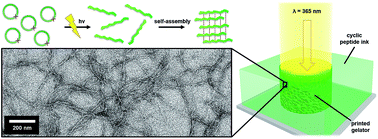
Faraday Discuss., 2019,219, 44-57
https://doi.org/10.1039/C9FD00026G
Nanolithography of biointerfaces
This article is based on the Concluding remarks made at the Faraday Discussion meeting on Nanolithography of Biointerfaces, held in London, UK, 3–5th July 2019.
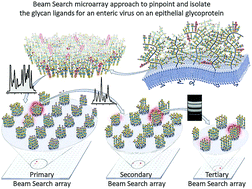
Faraday Discuss., 2019,219, 262-275
https://doi.org/10.1039/C9FD00082H
Factors contributing to variability of glycan microarray binding profiles
Glycan density and linker composition significantly influence binding on glycan microarrays.
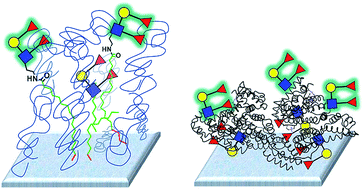
Faraday Discuss., 2019,219, 90-111
https://doi.org/10.1039/C9FD00021F
Hierarchically patterned striped phases of polymerized lipids: toward controlled carbohydrate presentation at interfaces
Microcontact printing can be used to generate well-defined microscopic areas of striped phases of both single-chain and dual-chain amphiphiles.
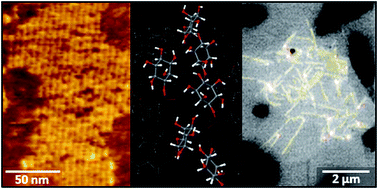
Faraday Discuss., 2019,219, 229-243
https://doi.org/10.1039/C9FD00022D
Multivalent glycan arrays
In this introductory lecture we discuss the state-of-the-art glycan microarray technology, with emphasis on novel approaches to immobilize collections of glycans in a defined, multivalent manner.

Faraday Discuss., 2019,219, 9-32
https://doi.org/10.1039/C9FD00080A
Biopolymer monolith for protein purification
Porous glycopolymers, “glycomonoliths”, were prepared by radical polymerization based on polymerization-induced phase separation with an acrylamide derivative of α-mannose, acrylamide and cross-linker in order to investigate protein adsorption and separation.
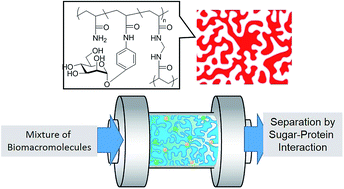
Faraday Discuss., 2019,219, 154-167
https://doi.org/10.1039/C9FD00018F
Multivalent binding of concanavalin A on variable-density mannoside microarrays
Variable density glycan microarrays were used to study the multivalent binding of lectins.
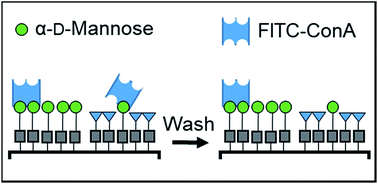
Faraday Discuss., 2019,219, 77-89
https://doi.org/10.1039/C9FD00028C
Engineering of spectator glycocalyx structures to evaluate molecular interactions at crowded cellular boundaries
Membrane engineering with bystander glycocalyx structures reveals altered protein–receptor association in crowded cell surface environments.
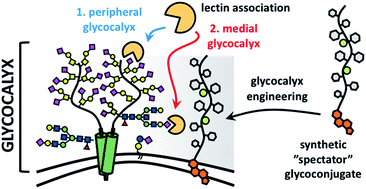
Faraday Discuss., 2019,219, 138-153
https://doi.org/10.1039/C9FD00024K
Mimicking the endothelial glycocalyx through the supramolecular presentation of hyaluronan on patterned surfaces
Self-assembled monolayers of hyaluronan (HA)-binding peptide allow immobilization of HA for studying the function of the endothelial glycocalyx.
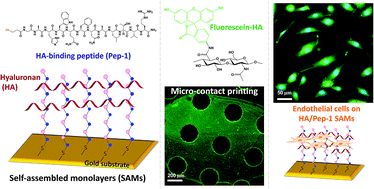
Faraday Discuss., 2019,219, 168-182
https://doi.org/10.1039/C9FD00015A
A ‘catch-and-release’ receptor for the cholera toxin
Thermoresponsive receptors for the recognition unit of the cholera toxin (CTB) can recognise the protein with nanomolar affinity. An increase in temperature can drastically reduce their avidity, enabling on-demand release of CTB.

Faraday Discuss., 2019,219, 112-127
https://doi.org/10.1039/C9FD00017H
Probing the nanoscale organisation and multivalency of cell surface receptors: DNA origami nanoarrays for cellular studies with single-molecule control
DNA origami nanoarrays with cell surface receptor ligands for cellular studies of human cutaneous melanoma cells and neonatal rat cardiomyocytes.

Faraday Discuss., 2019,219, 203-219
https://doi.org/10.1039/C9FD00023B
High-throughput protein nanopatterning
We demonstrate a high resolution and high-throughput patterning method to generate protein nanopatterns with sub-10 nm resolution by using thermochemical scanning probe lithography.

Faraday Discuss., 2019,219, 33-43
https://doi.org/10.1039/C9FD00025A
Binary polymer brush patterns from facile initiator stickiness for cell culturing
A new initiator stickiness method is reported to fabricate binary polymer brush micropatterns, which are ideal platforms for studying cell behavior.
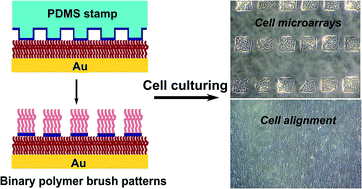
Faraday Discuss., 2019,219, 189-202
https://doi.org/10.1039/C9FD00013E
Poly(alkyl glycidyl ether) hydrogels for harnessing the bioactivity of engineered microbes
Herein, we describe a method to produce yeast-laden hydrogel inks for the direct-write 3D printing of cuboidal lattices for immobilized whole-cell catalysis.
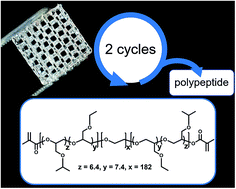
Faraday Discuss., 2019,219, 58-72
https://doi.org/10.1039/C9FD00019D
Magneto- and photo-responsive hydrogels from the co-assembly of peptides, cyclodextrins, and superparamagnetic nanoparticles
A hydrogel with dual response to magnetic fields and light is obtained from the co-assembly of peptides, cyclodextrins, and superparamagnetic nanoparticles.
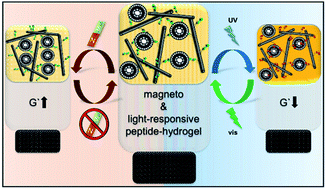
Faraday Discuss., 2019,219, 220-228
https://doi.org/10.1039/C9FD00012G
Charge-tuning of glycosaminoglycan-based hydrogels to program cytokine sequestration
Glycosaminoglycan (GAG)-based biohybrid hydrogels of varied GAG content and GAG sulfation pattern were prepared and applied to sequester cytokines.
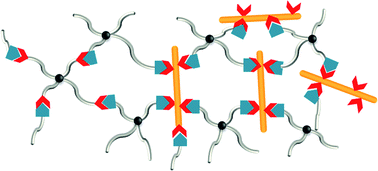
Faraday Discuss., 2019,219, 244-251
https://doi.org/10.1039/C9FD00016J
Glycan interactions on glycocalyx mimetic surfaces: general discussion
Faraday Discuss., 2019,219, 183-188
https://doi.org/10.1039/C9FD90063B
New directions in surface functionalization and characterization: general discussion
Faraday Discuss., 2019,219, 252-261
https://doi.org/10.1039/C9FD90064K
Multidimensional micro- and nano-printing technologies: general discussion
Faraday Discuss., 2019,219, 73-76
https://doi.org/10.1039/C9FD90061F
Preparation of multivalent glycan micro- and nano-arrays: general discussion
Faraday Discuss., 2019,219, 128-137
https://doi.org/10.1039/C9FD90062D
About this collection
We are delighted to share with you a selection of the papers which will be presented at our Faraday Discussion on Nanolithography of biointerfaces taking place in London, UK in July 2019. More information about the event may be found here: http://rsc.li/soft-lithography-fd2019. Additional articles will be added to the collection as they are published. The final versions of all the articles presented and a record of the live discussions will be published after the event.
In studying biological interfaces where carbohydrates are prevalent – such as the glycocalyx or extracellular matrix – scientists are only beginning to investigate how chemical composition, binding thermodynamics, and 3D structure work synergistically to control development, communication, and disease progression. Carbohydrate-binding is far less well understood than other types of biological interactions. The importance of reproducing the 3D structure of carbohydrate interfaces for understanding their physical and biological properties cannot be overstated.
Capturing the interfacial dynamics that drive the mechanical and biological properties of natural carbohydrate-based nanomaterials will require synergistic advances in 3D nanolithography, surface characterization, and organic and macromolecular chemistry at interfaces. However, many of the researchers working in this area come from disparate fields that rarely if ever communicate, including physical chemistry, surface chemistry, mechanical engineering, biology, and material science.
This Faraday Discussion aims to bring these communities together in a single symposium to create a new language for approaching the challenge of carbohydrate-based biointerfaces and will show how chemistry, particularly the combination of physical and organic chemistry, will continue to drive advances in the field, providing new approaches to understanding, and in turn, creating biomimetic materials with precisely controlled nanoscale structure in three dimensions.